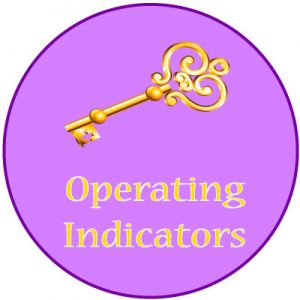Operators of direct selling companies need an accurate set of gauges for measuring the business. We call these measurements “Key Operating Indicators.”
 Without them, you will be flying your business partly in the dark!
Without them, you will be flying your business partly in the dark!
Key Operating Indicators are the most important measurements of your business. Direct selling owners and executives use these metrics to run their businesses month to month and year to year.
How Will KOI’s Help Me?
You’ve asked a great question, so you deserve a great answer. Here are 20 benefits to be gained from Key Operating Indicators.
1. Develop a more accurate sales forecast
When you know the activity rate of your independent representatives, the average order size, the number of orders per month per active consultant, and the rates of recruiting and attrition, you can forecast your sales!
2. Identify top performers and learn from them
When you measure the performance of each representative and their teams, you’ll see that not everyone’s metrics are the same. Some of your reps and their teams will be outperforming your average measurements by a significant variance.
“Who are these reps and what are they doing differently?” You should be asking these questions and obtaining the answers.
3. Spot reps in need of more training and support
Similarly, some reps and their teams will be underperforming the averages. These folks are obviously in need of additional training and support. When you know who they are, you can give it to them.
4. Create or amend your leadership development program
How do you know if your leadership development program is successful? You’ll know it by measuring the results. You can use your KOI’s to do just that.
5. Measure the effectiveness of your compensation plan
Key Operating Indicators can be used to assess the performance of your compensation plan. They can be used to pinpoint problems so that you can take decisive action. Questions like, “Is recruiting incentivized sufficiently?”, “Is my fast start program working?”, and “Are the requirements for promotion to higher titles set unevenly?” can all be answered with compensation KOIs.
6. Evaluate the success of your hostess program
Is your hostess program successful? You can find out by using KOIs to measure the important factors for success. If you don’t have them all, your hostess program is in need of adjustments.
7. Forecast personnel needs
Key Operating Indicators can be used to measure employee productivity. Together with your KOI’s for sales, you’ll have the information you need to forecast personnel needs into the future.
8. Make timely software acquisition decisions
How do you know when it’s time to invest in new MLM software? The answer is partly dependent upon the anticipated size of the business six months from now. How do you forecast this information? If your answer is “Key Operating Indicators”, you’re right!
9. Decide when to purchase inventory and how much
Key Operating Indicators can be used to measure what your representatives and retail customers purchase from your company. This information, together with your sales KOI’s, can help you forecast anticipated inventory purchases.
10. Make better fulfillment decisions
Should you outsource your fulfillment or keep it in-house? The answer to this question depends in part on your sales forecasts. It also depends on the total cost of fulfillment, comparing one approach with another. Sales KOIs are needed to help you to make informed fulfillment decisions.
11. Get better data for your business plan
Your business plan depends on measurements. Is yours up-to-date? Have they changed? Tracking Key Operating Indicators over time allows you to have more accurate information about the expected future of your business. As a result, your business plan can be more realistic.
12. Manage your cash flow
Key Operating Indicators can help you to manage your cash flow? Yes, they can because your needs for cash are impacted by the values of your Key Operating Indicators.
13. Identify positive and negative trends early
What is going on with your business? Truly, what is going on? Without measuring the important metrics, you won’t see all of the trends, positive and negative, or if you do see them, you certainly won’t see them early enough. Key Operating Indicators can give you the information you need to spot positive and negative trends early. With early detection, you can take action right away before it’s too late.
14. Know what’s working well and what’s not
Key Operating Indicators allow you to examine your business in a fine way. By fine, I do mean a good way but I also mean in a detailed way. By their very nature, KOIs measure discrete aspects of your business. By doing the measuring and the analysis of the results, you can see what’s working well and what’s not.
15. Hone in on the areas of the business to improve
When you know what’s not working well, you can focus on the problems. By continuing to measure your KOI’s, you’ll see the effects of the changes you’ve introduced.
16. Respond faster with targeted business changes
Speed is essential. The sooner you know exactly the problems, the faster you can remedy them.
17. Measure the impacts of changes to your business
When you introduce changes intended to strengthen one or more areas of your business, you can measure the impacts of your changes by examining all of your Key Operating Indicators.
18. Assess the health of your business from one month to another, and from one year to another
You want your business to be healthy. How should you compare this month to the past? You can do it by comparing one month to another, by comparing this month to the same month last year, and to the average of three years for this month, once you have some history behind you. Similarly, you can compare the performance of your business this year compared to previous years.
19. Compare your business with others similar to it
Key Operating Indicators are good ways to measure your business as compared to others. Like a blood test, the results can be compared to what is normal or expected for your type of business. For abnormal results, medicine may be needed!
20. Get the data you need to pilot your business
The biggest benefit of Key Operating Indicators is the most simple. KOIs will give you the information you need to pilot your business. Without this information, you won’t see everything around you. In effect, you’ll be piloting your business partly in the dark.
Types of Indicators
Direct selling businesses should have several types of key operating indicators. To start, we recommend the following types:
- Activity
- Sales
- Recruiting
- Recruit Activity
- Value of Representative
- Renewal
- Leadership
- Compensation Plan Performance
- Hostess Program Performance (for party plan companies)
Time Periods
Measurements should be taken or evaluated over different time periods. For example,
- Month
- Year
- Season
- Cumulative
- Enrollment Class
How should I track the numbers?
Track them at the lowest granular level (by rep, by order, by party, and by month).
How should I report the numbers?
Report your Key Operating Indicators in several ways, including:
- Actual numbers
- Actual against the plan (the budget for this year)
- Against the same month last year
- Against a rolling three-year average for the same month
Your Personal Best
There are typical ranges of values for most Key Operating Indicators. However, your business is unique in one or more ways. Measure your business using your own KOIs as the primary yardstick.
Don’t Wait
Start tracking and retaining these numbers by an independent representative, by party, by order, and by month right away. Changes in these numbers are your best gauge of what is working and what is not.
Questions?
For help with your Key Operating Indicators, contact Jay Leisner at Sylvina Consulting (503.244.8787 or (jay@sylvina.com).

 Jay Leisner, the President of Sylvina Consulting, is a top compensation plan and direct selling expert, a trusted adviser to new and established network marketing and party plan companies. For more than 30 years, Jay has enjoyed assessing and improving network marketing, party plan and referral marketing companies across the globe.
Jay Leisner, the President of Sylvina Consulting, is a top compensation plan and direct selling expert, a trusted adviser to new and established network marketing and party plan companies. For more than 30 years, Jay has enjoyed assessing and improving network marketing, party plan and referral marketing companies across the globe.
Annette Hunter says
Great article! One step I believe should be included in any plan to measure or quantify success is the recognition process. There are many ways to follow the ROI for a good sales incentives program, and therefore the data can be captured, measured and implemented in an increasingly improved process.
As we are all aware, recognition is sometimes as big a motivator as the compensation plan itself (if not more in some cases).
All in all, a very detailed step-by-step plan. Thanks for posting this!